
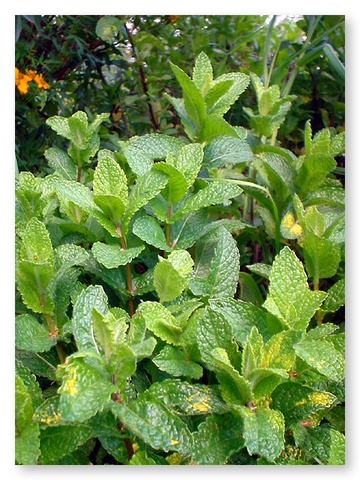 Most likely an apple mint (Mentha suaveolens}, this plant sports lavender spikes when in bloom
Most likely an apple mint (Mentha suaveolens}, this plant sports lavender spikes when in bloom
Mints (Lamiaceae) are a large family of perennial herbs, mostly native to temperate regions of the Old World and widely spread over temperate parts of the world. The mint family includes about 3000 species of plants, very fragrant and rich in medicinal properties. Mints typically prefer moist soil and bear small lavender or purple flowers in summer; they are characterized in part by their square stems and opposing leaves, with each pair of leaves at right angles to the ones above and below it.
Mints develop their best colors and flavors when grown in the sun. There are two growth phases for mints: the first, in early spring, will be evident as the stems head up to make flowers — flower spikes bloom from the bottom up and continue to elongate even as they blossom. After flower production, the second phase kicks in and horizontal runners take off and cover a lot of distance in a short time. Honeybees and butterflies love mint flowers, not to mention those of us who are fond of drinking mojitos in the garden.
Members of the mint family include about 200 genera including ajuga, hyssop, lamium, lavender, mentha, oregano, sage (including rosemary), & thyme. Of these, mentha is most typically identified as "mint." Mentha are is easy to distinguish because of their rough, wrinkled, & hairy leaves, square stems, and flowers in long spikes.
Native Plants
Ten species of mints are native to Davis, and seven others are native to other parts of Yolo County.
American Bugleweed (Lycopus americanus) is a perennial herb that is native to Davis and to most of the portion of Yolo County that is in the Sacramento Valley. It grows one and a half feet tall and prefers partial shade. Indigenous Californians have traditionally used it as a dye.
American Field Mint (Mentha arvensis) is a perennial herb that is native to Davis and southern Woodland. It can grow a little over two feet tall (but usually stays closer to one foot) and spreads horizontally by rhizomes. It prefers full sun and wet areas. It can be made into mint tea, mint jelly, or mint leaf candy.
American Corn Mint (Mentha canadensis) is a perennial herb that is native to Davis and to most of the portion of Yolo County that is in the Sacramento Valley. It grows one and a half feet tall and spreads horizontally by rhizomes. It prefers full sun and wet areas, although it does not grow directly in water. Its foliage has a peppermint scent. Indigenous Californians have traditionally used it as a remedy for bad breath or toothache, or to bait foxes or bobcats.
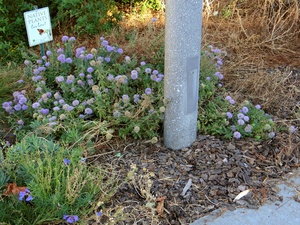 Coyote Mint (Monardella villosa) in a garden in Woodland. Photo by queerbychoice.Coyote Mint (Monardella villosa) is a perennial herb that is native to western Davis, western Woodland, and the portion of Yolo County that is westward of a line drawn between the midpoints of Davis and Woodland. It grows about one foot tall and three feet wide and prefers full sun or partial shade. It can be steeped into a mint tea, which Indigenous Californians have traditionally used as a remedy for nausea, respiratory conditions, and sore throat.
Coyote Mint (Monardella villosa) in a garden in Woodland. Photo by queerbychoice.Coyote Mint (Monardella villosa) is a perennial herb that is native to western Davis, western Woodland, and the portion of Yolo County that is westward of a line drawn between the midpoints of Davis and Woodland. It grows about one foot tall and three feet wide and prefers full sun or partial shade. It can be steeped into a mint tea, which Indigenous Californians have traditionally used as a remedy for nausea, respiratory conditions, and sore throat.
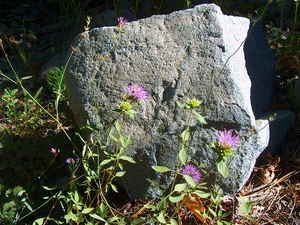 Mountain Mint (Monardella odoratissima) in the wild. Photo by queerbychoice.Mountain Mint (Monardella odoratissima) is a perennial herb that is native to most of Woodland (the northwestern three quarters or so of town) and to rural areas north of Woodland. It grows about one foot tall and prefers full sun or partial shade. It can have white, pink, or purple flowers.
Mountain Mint (Monardella odoratissima) in the wild. Photo by queerbychoice.Mountain Mint (Monardella odoratissima) is a perennial herb that is native to most of Woodland (the northwestern three quarters or so of town) and to rural areas north of Woodland. It grows about one foot tall and prefers full sun or partial shade. It can have white, pink, or purple flowers.
Douglas' Mesa Mint (Pogogyne douglasii) is an annual herb that is native to Davis and to most of Yolo County except for the Capay Hills. It grows one and a half feet tall and prefers full sun and vernal pool conditions.
Sacramento Mesa Mint (Pogogyne zizyphoroides) is an annual herb that is native to Davis and to most of the portion of Yolo County that is in the Sacramento Valley. It grows up to six inches tall and prefers full sun and vernal pool conditions.
Thymeleaf Mesa Mint (Pogogyne serpylloides) is an annual herb that is native to the Yolo County foothills (not including the Capay Hills). It grows only a little over one inch tall and has pale purple flowers.
Bugle Hedgenettle (Stachys ajugoides) is a perennial herb that is native to Davis, Woodland, the Dunnigan Hills, and the portion of Yolo County that is eastward of those locations. It grows up to one foot tall and prefers full sun and wet, meadowy areas.
Rough Hedgenettle (Stachys rigida) is a perennial herb that is native to southeastern Davis, West Sacramento, the southeastern tip of Yolo County, and the Yolo County foothills, including the Capay Hills. It grows a little over three feet tall.
Sonoma Hedgenettle (Stachys stricta) is a perennial herb that is native to western Davis, all of Woodland, and most of the area westward of those locations. It grows about two and a half feet tall.
Vinegar weed (Trichostema lanceolatum) is an annual herb that is native to western Davis, all of Woodland, and most of the area westward of those locations. It grows a little over three feet tall and prefers full sun and dry, sun-baked, nutrient-poor clay soil. Its foliage has a strong vinegar scent that becomes stronger during hot weather. The scent comes from volatile oils that are toxic to some other plant species, making it harder for other plants to compete with it for nutrients. Indigenous Californians have traditionally used Vinegarweed as a cold and fever remedy, a pain reliever, and a flea repellent.
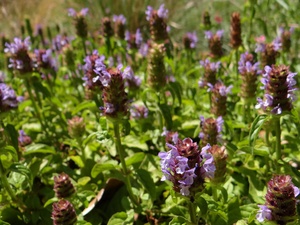 Selfheal (Prunella vulgaris) in a garden. Photo by queerbychoice.Selfheal (Prunella vulgaris) is a perennial herb that is native to Monument Hills and the flatlands just west of the Davis/Woodland metropolitan areas, as well as some of the southeastern Dunnigan Hills. It usually grows about six inches tall and spreads horizontally by rhizomes. Fragrant and fast-growing, with purple flowers, it often volunteers in the shady or partly shady areas watered lawns. It usually does not grow in wetlands but does prefer the slightly damp areas of uplands (non-wetlands). It seems to have originated in Europe, but it spread to California (and to temperate climates throughout the world) long before European humans did, so it is considered native here due to how long our native ecosystems have had to adapt to it. It has been used for healing purposes by many cultures throughout the world.
Selfheal (Prunella vulgaris) in a garden. Photo by queerbychoice.Selfheal (Prunella vulgaris) is a perennial herb that is native to Monument Hills and the flatlands just west of the Davis/Woodland metropolitan areas, as well as some of the southeastern Dunnigan Hills. It usually grows about six inches tall and spreads horizontally by rhizomes. Fragrant and fast-growing, with purple flowers, it often volunteers in the shady or partly shady areas watered lawns. It usually does not grow in wetlands but does prefer the slightly damp areas of uplands (non-wetlands). It seems to have originated in Europe, but it spread to California (and to temperate climates throughout the world) long before European humans did, so it is considered native here due to how long our native ecosystems have had to adapt to it. It has been used for healing purposes by many cultures throughout the world.
White Pitcher Sage (Lepechinia calycina) is an aromatic shrub that is native to the Yolo County foothills, including some of the higher Capay Hills. It grows up to eight feet tall and six feet wide. It prefers full sun or partial shade, dry conditions, and excellent drainage. The Miwok people of California have traditionally used an extract of the leaves of this plant to treat fever and headache.
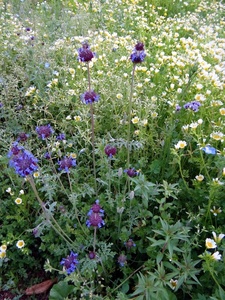 Chia (Salvia columbariae) in a garden, mixed with Douglas meadowfoam (Limnanthes douglasii). Photo by queerbychoice.Chia (Salvia columbariae) is an annual herb that is native to the Yolo County foothills, including the Capay Hills. It grows up to one and a half feet tall but not as wide. It prefers full sun and dry conditions. An important traditional food for Indigenous Californians, it is related to but different from the species of chia commonly sold in grocery stores or with chia plants.
Chia (Salvia columbariae) in a garden, mixed with Douglas meadowfoam (Limnanthes douglasii). Photo by queerbychoice.Chia (Salvia columbariae) is an annual herb that is native to the Yolo County foothills, including the Capay Hills. It grows up to one and a half feet tall but not as wide. It prefers full sun and dry conditions. An important traditional food for Indigenous Californians, it is related to but different from the species of chia commonly sold in grocery stores or with chia plants.
California Skullcap (Scutellaria californica) is a perennial herb that is native to the Yolo County foothills, including the Capay Hills. It grows about one and a half feet tall and spreads horizontally by rhizomes. It prefers partial shade.
Danny's Skullcap (Scutellaria tuberosa) is a perennial herb that is native to the Yolo County foothills, including the Capay Hills. It grows about one foot tall and spreads horizontally by rhizomes. It prefers full sun or partial shade.
For a list of other plants found growing within Davis, please visit our Town Flora page. For a list of plants native to Davis, visit our Native Plants page.



